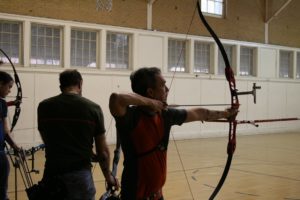One of the most frequent questions I get as a coach is, ‘What spine of arrow should I buy?’ I don’t know why this is such a daunting process, but so much poor published information is out there, it’s a wonder anybody gets it right, especially when it regards low poundage recurve bows.
All the manufacturers can do a much better job at publishing better information. Easton does the best job at this point and I’ll refer to their chart a bit later.
You’ll need a few pieces of information to make a reasonable choice of arrows. The first is understanding what poundage you’re shooting when at full draw. This is not the poundage at which your limbs are rated. You’ll need someone to actually mark an arrow when you are at full draw and then draw the bow on a scale. Secondly, you’ll need to determine how long your arrow will be when finished. This is measured by the groove of the nock, to the end of the arrow shaft. Now you can go to the Easton spine chart and make an initial determination of what spine choices you have. There will be perhaps 2 or 3 different spine arrows which might work for you. There is one more factor to consider and that is how the arrow is constructed. Tapered, or barreled shafts will be perhaps 1 to 2 spine groups weaker than a parallel shaft. The reason for the difference in construction is to allow the arrow to bend more easily around the bow. This is especially important for a recurve shooter.
Ok, now you’re looking at the spine chart and shaking your head over which of the recommendations is the correct choice for you. If you’re leaving the arrow extra long, as many youth shooters do, opt for a weaker shaft, as the section of arrow you are flexing will be less. This may necessitate going to an even weaker spine group than what the chart is showing. If you are shooting a finished arrow which is close to your draw length, the chart becomes more accurate and you’ll be able to choose from the selections offered. Easton differentiates youth spine recommendations from adult choices. Still, the correct choice may lie outside of the table recommendation.
Well, if you’re still with me, you might have a better grasp of which arrow to buy. Some of the mistakes made can be quite costly as arrows poorly chosen will not be able to be tuned and fly poorly. That’s where an experienced coach can save you a bunch of money. You see, there are more variables to consider, such as stabilization, or lack there of………..and more. Heck, coaches aren’t perfect either and we sometimes get it wrong. But by all means collaborate with your coach to help you succeed in choosing properly.
One final note. Some charts are just plain horrific. The VAP chart is just about worthless for recurve shooters and I’ve seen lots of money poorly spent on VAP shafts which were over spined.
http://www.meigarco.com/Reglamentos/Guia-EASTON-seleccion-flechas.pdf




